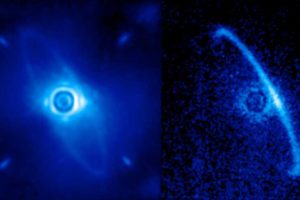american astronomical society
Taking the pulse of a black hole system
Using two NASA X-ray satellites, astronomers have discovered what drives the “heartbeats” seen in the light from an unusual black hole system. These results give new insight into the ways that black holes can regulate their intake and severely…
Possible missing link between young and old galaxies
University of California, Berkeley, astronomers may have found the missing link between gas-filled, star-forming galaxies and older, gas-depleted galaxies typically characterized as “red and dead.”
In a poster to be presented this week at t…
Astronomers find seven planet-forming disks, doubling total
A mammoth sky survey led by University of Florida astronomers has uncovered seven planet-forming disks in clusters of young stars, doubling the number of such disks discovered and expanding the territory that might yield new planets.
Three Distant Quasars Found at Edge of the Universe
Astronomers have discovered three of the oldest, most distant quasars yet found — quasars close to the Big Bang that began the universe. Xiaohui Fan of the University of Arizona’s Steward Observatory in Tucson, Ariz., will present the results at the American Astronomical Society’s meeting in Seattle. Fan, leader of the team that discovered the objects, explained that these distant quasars — compact but luminous objects thought to be powered by super-massive black holes — reach back to a time when the universe was just 800 million years old. The highest redshift quasar is roughly 13 billion light years away and was discovered recently in the constellation Ursa Major.
Giant Radio Jet Coming From Wrong Kind of Galaxy
Giant jets of subatomic particles moving at nearly the speed of light have been found coming from thousands of galaxies across the Universe, but always from elliptical galaxies or galaxies in the process of merging — until now. Using the combined power of the Hubble Space Telescope, the Very Large Array (VLA) and the 8-meter Gemini-South Telescope, astronomers have discovered a huge jet coming from a spiral galaxy similar to our own Milky Way.
Astronomers identify new type of star
A new type of star has been discovered lurking as a low mass component in a very compact binary star system. Astronomers announced today at the American Astronomical Society Meeting in Seattle, Wash., that they have confirmed the existence of a new variety of stellar end-product. This previously unknown type of star has some properties similar to brown dwarf stars and may help astronomers understand some of the recently discovered extra-solar planets in close proximity to their suns.
Astronomers Detect a Faint Debris Trail in the Andromeda Galaxy
The discovery of a faint trail of stars in the nearby Andromeda galaxy offers new evidence that large spiral galaxies have grown by gobbling up smaller satellite galaxies. Andromeda (also known as M31) is the nearest large galaxy to our own Milky Way and is very similar to it in appearance. Studying Andromeda gives astronomers an external perspective on a galaxy much like our own–it’s like looking at a bigger sibling of our galaxy.
Supernova Factory announces 34 supernovae in one year
The Nearby Supernova Factory (SNfactory), an international collaboration based at Lawrence Berkeley National Laboratory, today announced that it had discovered 34 supernovae during the first year of the prototype system’s operation — all but two of them in the last four months alone. The announcement was made at the 201st meeting of the American Astronomical Society in Seattle. “This is the best performance ever for a ‘rookie’ supernova search,” said Greg Aldering of Berkeley Lab’s Physics Division, principal investigator of the SNfactory. “We have shown we can discover supernovae at the rate of nine a month, a rate other searches have reached only after years of trying.”
Extrasolar meteors hint at distant planet formation
Candian astronomers say that detecting microscopic meteors from other solar systems could provide clues about the formation of planets like Earth. Dust streams from our sun’s stellar neighbours consist of tiny grains of pulverized rock ejected from a disk of dust and debris that commonly surrounds young stars, says Joseph Weingartner, a post-doctoral fellow at the University of Toronto’s Canadian Institute for Theoretical Astrophysics. According to Professor Norman Murray, associate director of CITA and co-author of the study, “if we can detect these grains and trace them back to the star system that they came from, we’d have very good evidence of planet formation going on in that system.” Weingartner presented the study Jan. 6 at the American Astronomical Society meeting in Seattle, Wash.


